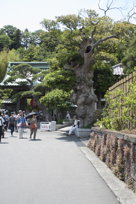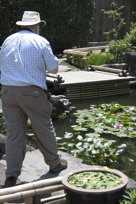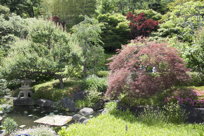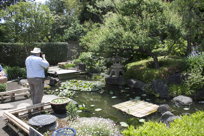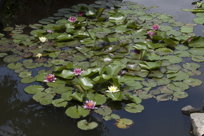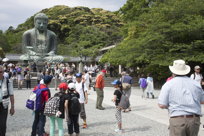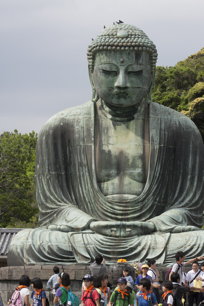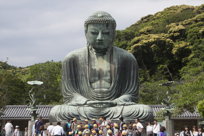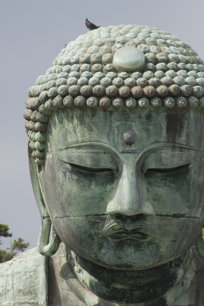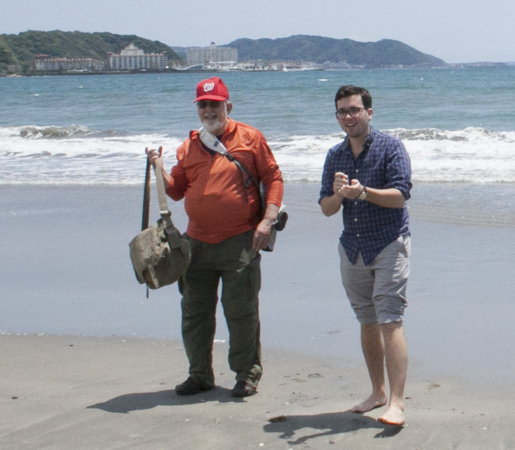
|
|
At Hase, those of us who wished to could dabble feet into the waters of the western Pacific. Mason did, Mike didn’t. |
Thursday, 22 May: a big Buddha and a great hike
Our last day in Tōkyō, but we had one more great Japanese breakfast, checked out, and took all our stuff to the JR station. From there to Ōfuna, where we dropped the luggage off at the hotel we’d be staying at for a night. From there we walked to the station of the Shonan Monorail, which would take us to the Shonan-Enoshima station.
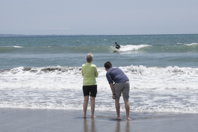
The monorail ride was an experience in itself in that the route has a number of surprisingly steep ascents and descents, and is frequently crowded by vegetation. Lots of fun. Mark has some pictures, I don’t. At Enoshima, we took another JR train, to Hase. We could walk to the sea from the Hase train station, and as you see to the left, Cindy and Mason both got their feet wet.
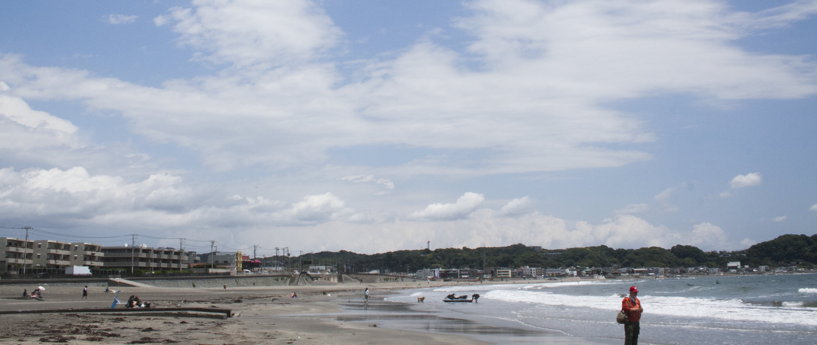
|
|
I wonder whether I took this picture of the beach and the sky at Hase
knowing what the sky would bring later on. (You can get a somewhat larger version by clicking on the picture.) |
We walked past the station to get to Hase-dera, a temple with a notable statue of Kannon, which we saw, but couldn’t take pictures of. For me, though, the important feature of the temple was the extensive gardens associated with it.
Not all that much to say about the block of pictures to the right. In the first picture in the left column, we’re entering the temple precinct; in the bottom picture in the right, the variety of water lilies was clearly an object of Mark’s envy. We now have a little pond for water lilies at home, but the maximum number of plants will be two.
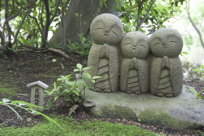
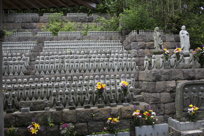
Still at the Hase-dera, the little statues at the upper left are seemingly jizo, a deity protecting travelers, children, and vulnerable people generally. I wonder whether the rank upon rank of small statues in the lower picture also are jizo.
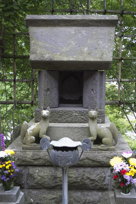
I think that all of us took pictures of the little shrine shown at the right, with its guardian foxes.There was something charming, winning, about it.
When we were on the beach at Enoshima, the sky had seemed bright and untroubled. But by the time we got to Hase-dera, there were indications that trouble might be ahead, especially threatening to the long hike that Mike had scheduled for us later in the day. Hase-dera is built into a hill, and we could look out on the Kamakura harbor, and from a sort of observation-platform, I got the two shots below, showing the threatening skies.
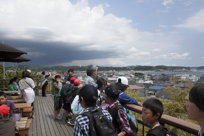
|
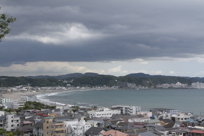
|
|
Rain clouds coming! (big image, small). |
Close-up of the same (big image, small). |
No matter, we walked to the Kōtoku-in, the Buddhist temple that contains the great Buddha of Kamakura, Daibutsu. Even though it was clearly going to be a rainy afternoon, the sun shone pleasantly through all my picture-taking, as you see to the right. I pulled out my camera’s long-focus lens for the last two shots—it’s heavy, but sometimes worth the bother.
The weather was looking worse and worse, so we did not delay here, but started out on our hike, which would take us over a ridge to a nearby rail station, Kita-Kamakura.
As we left the Daibutsu shrine, was clearly going to rain, so I packed my camera away, and that was the end of picture-taking for me for the day. I made sure my raincoat was handy, and before long, I had to put it on. From here on, I quote my journal:
«The idea was to take a well-known trail for a hike of several miles. It started with stairs, stairs, stairs, and continued with a climb by way of tree roots to be grasped. Very strenuous for this old geezer, and I was frequently wondering how [the ticker] was working. Finally, finally, we came to the summit, and could enjoy the level for a while.
«But I haven’t mentioned the rain. It never came down in sheets, but it was almost as strong as that for about a half hour. We were soon soaked, those parts of us not protected by rainhat and rainjacket. This means mostly pantlegs, but I guess Cindy’s shoes were totally soaked. I was worried about my backpack, which Cindy had kindly offered to shoulder. I figured that the canvas, even if not impermeable, would let the rain run off rather than in. As it turned out, when I finally opened the pack in our hotel room, many of the papers were wet or soaked, and there actually was liquid water visible in the main (camera) compartment. And my camera was even noticeably moistened, though apparently not harmed. […]
«When we were almost all the way to the railway station, Mason spotted what he thought was a cave, but which turned out to be a tunnel to a very charming little shrine. Small in comparison to Hase-dera and Kōtoku-in, but still big enough. It had lots of school kids enjoying themselves and sheltering from the rain, which by now had tapered off considerably and become intermittent sprinkles.
«A lot more walking and a closed (too late!) temple before we got to a likely restaurant in Kita Kamakura, but they couldn’t accomodate us—empty—they had reservations for later—this was about 6:15—and I guessed that they didn’t have enough food for unexpected guests.
[We walked a lot more and it was getting late] «so we decided to take the train the short ride back to Ōfuna, where there were many many many eating places. [It’s a commercial center of some importance.] Mason dragged us into a doorway where we mounted to the second floor, a real dive to my over-delicate eyes. The food there was perfectly fine, and we all except Mark had two beers. The waitress was fun, even without English, and we had a great and relaxed time.

Sound asleep
[Back in our room at the hotel in Ōfuna where we had earlier left our luggage] «Mark was sound asleep before I finished fussing with my soaking pack and its endangered contents; and I finally turned out the light at 9:00.»
